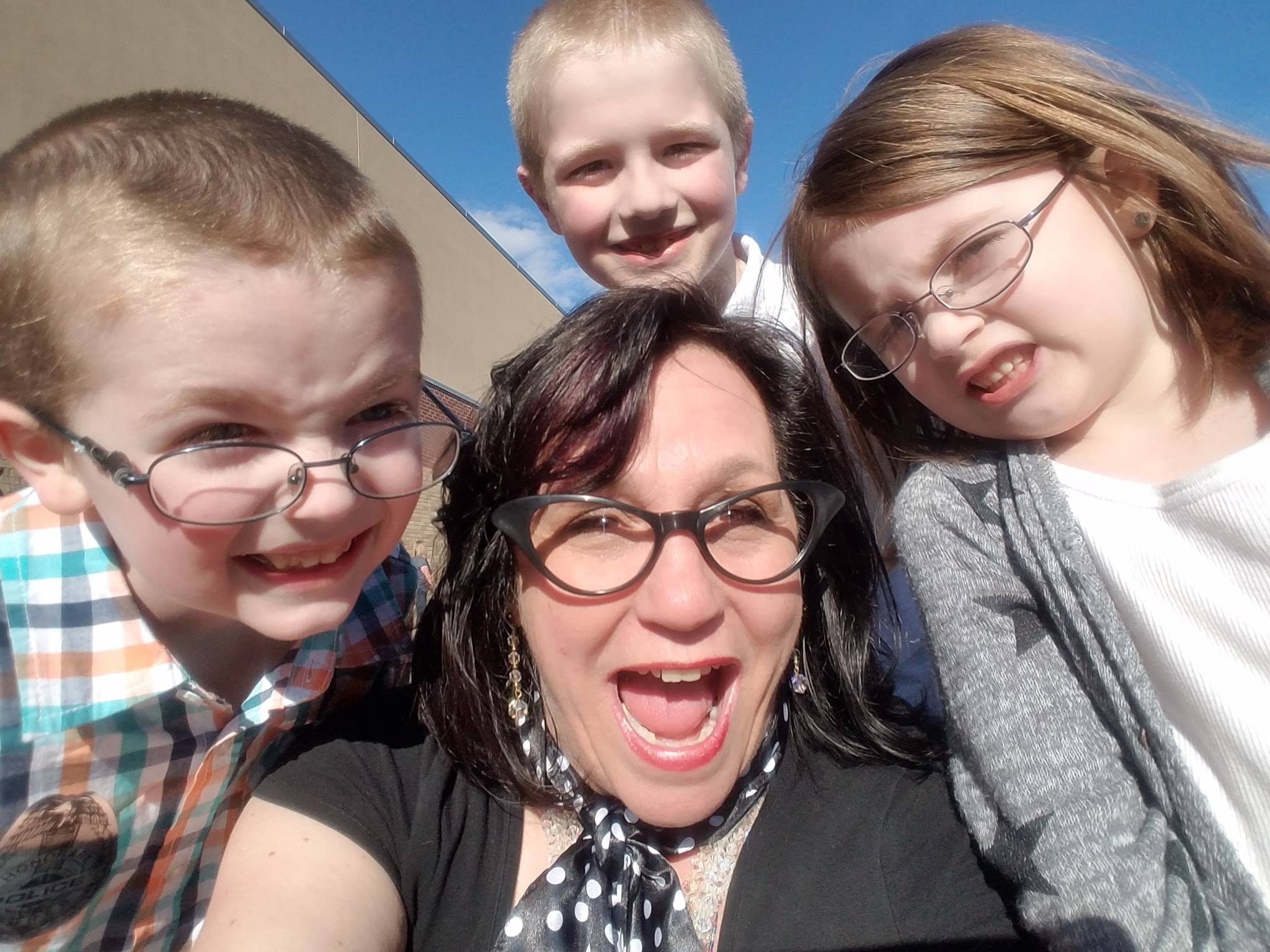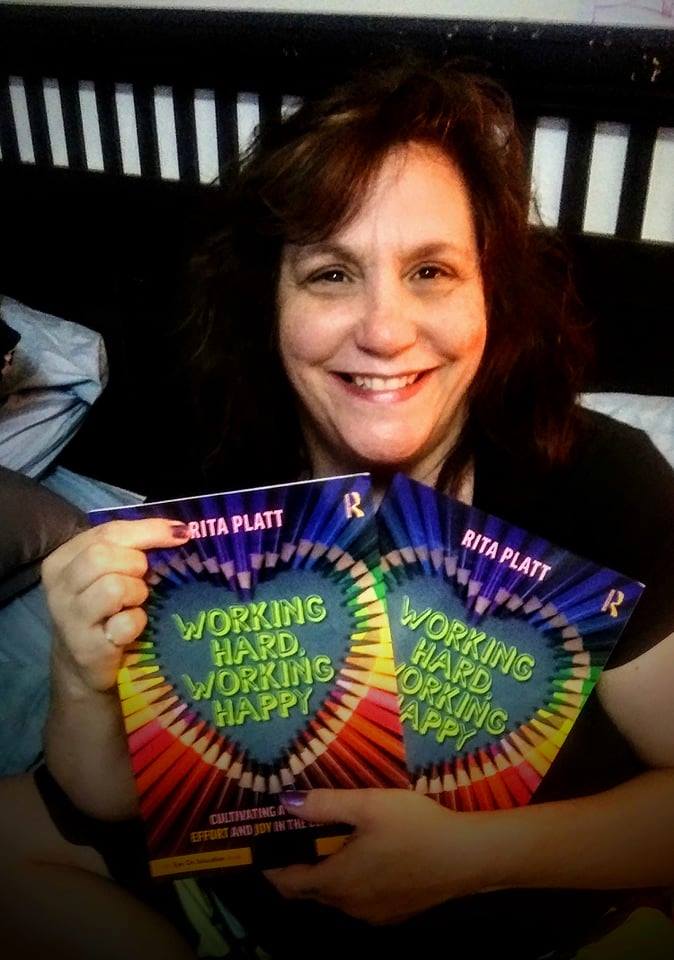Working Hard, Working Happy! Effort and Joy Should be BFFs in Your Schoolby Rita Platt, Principal of St. Croix Falls and Dresser Elementary Schools
The room is clearly arranged to meet learners’ various needs. About half of the tables at the center of the room are filled with small groups of students talking quietly as they work on gathering and sharing information for a project. There are three study carrels on the back wall with signs above them that read, “Shhh! Quiet Study Area!” One of the carrels houses a child who is independently reading and taking notes from an article. Along another wall is a tall table with barstools for seating; there, students are working in groups of two with laptops open. Mrs. Miner’s desk is in the far back corner of the room but it is empty. She sits at a kidney-shaped table near the front door working with three students. You notice that she occasionally points to the chart on the wall behind her to emphasize a point. The Big Idea Most principals would love to have a school full of classrooms like the one described above. It is a classroom that buzzes with cheery productivity, and that type of classroom is wonderful for all who have a stake in it. From teachers and students to parents and administrators, everyone wins when classrooms are focused on learning, yet joyful. Mrs. Miner’s classroom is an example of a place where learning and joy go hand in hand, and that is what my new book Working Hard, Working Happy is all about. My Five-Part Philosophy In a nutshell, the most effective classrooms are those where students and teachers alike are happy and hardworking. The best classrooms are those that have heady doses of both fun and high expectations. My philosophy of education boils down to a list of five things I know to be true about teaching and learning. In my experience, these are among the most important truths for successful educators.
All children want to learn and all crave challenge. Students thrive when they work to meet challenging goals in supportive learning environments. So-called “failure” is a part of learning and should be celebrated as part of the process. In the book, you’ll read about the research on growth mindset, as well as encounter the scholarship on harnessing the power of “failure” as a way to help students recognize themselves as active learners.
Students with teachers who support the goal of helping them make at least a year’s growth in a year’s time are bound to achieve more than are students in classrooms where no such expectation is maintained.
Students are in school for a huge chunk of every day. Teachers can and should be actively working to make that time as joyful as possible. When students are happy, they are likely to be motivated to work harder.
Don’t make the mistake of thinking that a joyful classroom is equivalent to a free-for-all environment. Remember, the premise of this book is that joy and serious learning go hand in hand. Joyful classrooms can look and sound very different depending on the teacher, the lesson, or even the time of day. While games, jokes, and other fun can be a part of a joyful classroom, so can a productive buzz or even a completely silent learning space.
Coaching can be defined as the art and science of helping someone achieve their goals through explicit teaching, modeling, hands-on guided practice, and lots of independent practice. Teachers cannot make learning happen; they can, however, help students acquire knowledge, skills, and tools so that students can make it happen for themselves. The coaching model places the students’ learning efforts at the center of the classroom, while preserving and valuing the teacher’s expertise in guiding, troubleshooting, and supporting those efforts.
Motivation comes from success and from feeling good about your work; it comes from “seeing” growth through setting, monitoring, and meeting learning goals. Motivation is not something we give to students; it is something we teach to students.
Real motivation comes from seeing success as possible. Recognition and celebration of growth toward goals should be frequent and pointed. Sometimes, that means a sticker, a certificate, a star on a chart or some other token, but most of the time it means conferring with students so that they begin to see the results of their own hard work to learn and grow.
Unless a teacher has her or his finger on the pulse of the classroom and can easily facilitate student transitions, stay organized, keep disruptive behavior to a minimum, and have fun, she or he cannot effectively teach.
If students are to make progress in their own areas of need, teachers must be able to flexibly differentiate instruction so that all learners have access to rigorous content in a safe and orderly environment. Differentiated instruction has a reciprocal relationship with classroom management.
Do you agree with the five-part philosophy? What would you change to make it better fit your own experiences and beliefs about what constitutes good teaching? Define your own philosophy of learning. Ask yourself the following questions and use the answers to guide you. Then think about what your philosophy has to do with your role as a school leader.
Want More?
Rita Platt (@ritaplatt) is the principal of St. Croix Falls and Dresser Elementary Schools. She is a National Board Certified teacher and a proud #EduDork with experience teaching learners of all levels from kindergarten to graduate student in schools across the nation including remote Inuit villages on the Bering Sea Coast of Alaska, inner-city schools in Las Vegas, and everywhere in between. Rita teaches graduate courses for the Professional Development Institute, writes for MiddleWeb, and recently published her first book with Routledge Eye on Education and Middle Web. Working Hard, Working Happy: Cultivating a Climate of Effort and Joy in the Classroom is available on Amazon and the Routledge website. Reach Rita on Twitter (@ritaplatt) or by email [email protected]
Read more at:
Elementary Edition - Secondary Edition - District Level Edition
|

 As you enter Mrs. Miner’s sixth grade classroom the first thing you notice is that all students are on task. Students are everywhere but all seem to be engaged in the learning target set forth by the teacher. Moreover, everyone seems happy! Students sit close to one another, smile often, and their quiet whispers are often punctuated by laughter.
As you enter Mrs. Miner’s sixth grade classroom the first thing you notice is that all students are on task. Students are everywhere but all seem to be engaged in the learning target set forth by the teacher. Moreover, everyone seems happy! Students sit close to one another, smile often, and their quiet whispers are often punctuated by laughter.  My book,
My book,